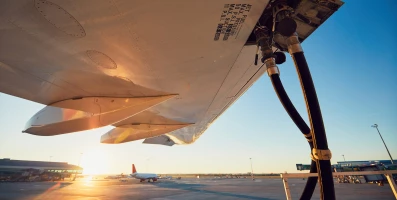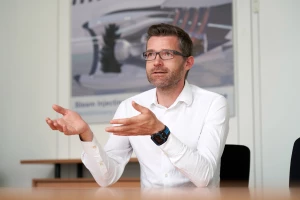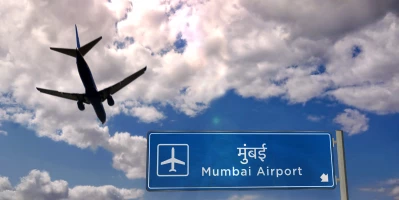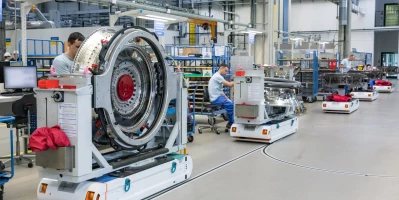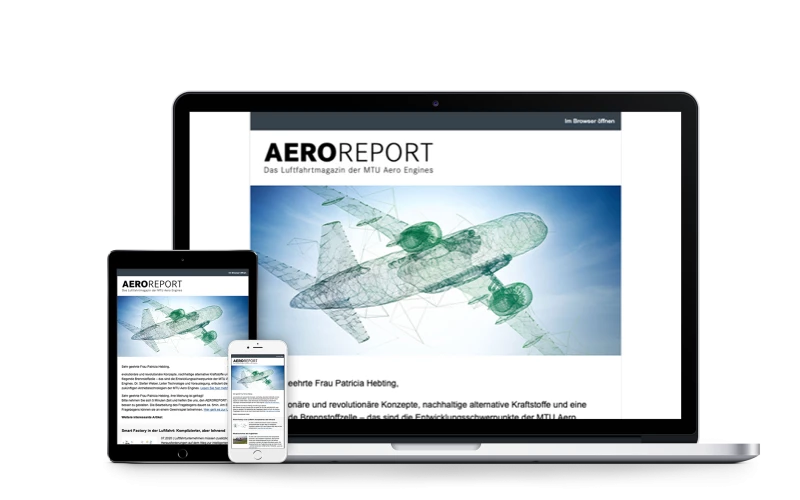aviation
Better flight connections
To cope with the global rise in air traffic between urban centers, we are going to need quieter aircraft and more efficient airports. Big data applications are among the solutions helping to get passengers and luggage to their destinations quicker than ever.
11.2016 | author: Denis Dilba | 10 mins reading time
author:
Denis Dilba
holds a degree in mechatronics, is a graduate of the German School of Journalism, and founded the “Substanz” digital science magazine. He writes articles about a wide variety of technical and business themes.

It is a well known fact that we can expect air traffic to grow rapidly over the coming years—though the sector disagrees slightly on exactly what that yearly growth will be. At this year’s International Airshow in Farnborough in the UK, for instance, Airbus and Boeing were talking about a global growth rate of 4.5 percent per year up to 2035, while the International Air Transport Association (IATA) puts the increase at a somewhat more modest 3.8 percent per year. Still, we are long past quibbling about how large exactly the increase in air traffic will be—today, the important questions are where that growth will take place, what impact it will have and how we can keep pace with the soaring demand for mobility.
According to the current forecasts of the United Nations, the bulk of global population growth—and thus potential passenger increases—will take place in cities. Back in 1950, just 30 percent of the population lived in urban areas, a figure that now surpasses 50 percent and which experts expect to exceed two thirds of the population after 2050. While urbanization has reached an advanced stage in the countries of the West, it is just taking off in Asia, Latin America and Africa. In China and India in particular, cities have boomed, bringing with them an affluent and consumer-oriented middle class. As income increases, these people can afford to fly more. If population growth remains on or near its current course until 2050, we must be prepared for a three- to fourfold increase in air traffic.


The CentAirStation concept by Bauhaus Aviation
New, smaller airports directly in inner cities are set to help meet air traffic challenges in the year 2040 and beyond.
Infrastructure on the ground
“The question is how infrastructure can keep pace with mobility needs in such rapidly expanding cities,” says Kay Plötner from the Bauhaus Luftfahrt think tank in Munich. The aerospace engineer is one of those involved in a concept that could provide an elegant solution to the problem: new, smaller-sized airports located directly in city centers and offering direct links to each other and other already existing airports. Plötner and his colleagues have called the study, which they presented at the 2016 Berlin Airshow, “CentAirStation.”
The idea is to build four-storey buildings over existing underground and municipal railway lines, providing a place for aircraft to take off and land. You could think of it as a sort of aircraft carrier, just on land, says Plötner. The flight deck is 650 meters long and 90 meters wide, while the floor below is used for boarding and clearance. One floor below that, there is security and luggage drop-off as well as restaurants and shops accessible from the trains arriving at ground level. “Our vision is that passengers should be able to take off no more than 15 minutes after arriving on the train, and be able to exit the building within 10 minutes of landing,” says Bauhaus researcher Plötner.
It should be noted that the CentAirStations are designed to work only with a new type of aircraft, the “CityBird.” Plötner explains that this would be a short-haul aircraft with around 60 seats and a range of 2,700 kilometers. Engines with a high bypass ratio are to combine modern turbo components with piston technology, allowing for particularly low NOx emissions. MTU Aero Engines is one of those who has worked on the pioneering composite cycle engine concept. In addition, a catapult launch is to boost the drive power needed for takeoff, making operations even quieter. However, the CityBird is also designed to be able to land and take off from traditional airports—ultimately, the idea is to complement existing airports, not replace them, says Plötner.
Four hours door to door
Bauhaus’s idea could play an important role in fulfilling one of the European Commission’s ambitious targets for “Flightpath 2050”: that, by mid-century, 90 percent of all journeys in Europe should take no longer than four hours door to door. Florian Rudolph, a researcher at the German Aerospace Center DLR’s Institute of Air Transport and Airport Research, illustrates just how difficult that is in today’s world: “If I want to fly from Braunschweig to Paris via Hannover and be sure of catching my flight, I have to factor in a buffer for any bus and train delays and set off from home three hours before my flight,” says Rudolph. When you add in the flight time, the four-hour target is long surpassed.
In the DLR Optimode research project, Rudolph and his colleagues have examined how buses, trains and airlines can be better coordinated so that travelers can be sure of catching their flights without having to plan in buffer time. “If airlines, bus and train companies know that air passengers are sitting in a bus or train on their way to the airport, they can calculate alternative routes, put on extra connections or arrange speedy boarding in the event of any delay,” says Rudolph. “Passengers would be kept informed about these developments via a live app. Should the delay prove too great, the system would calculate a new connection and get the passenger to their destination by another route,” says Rudolph.
It all sounds quite simple, but it is a real challenge in practice. Currently, airlines only know for sure that a passenger is actually going to fly when they board on the day of their flight. So that transportation operators can react flexibly, travelers would have to be prepared to share details about their location with bus and train companies as well as with the airline. The experts at the DLR envisage that this will happen automatically, for instance by scanning a bus or train ticket and comparing it against GPS coordinates relayed by a smartphone. When the passenger enters the airport, they confirm that they have arrived with a barcode scan. Still, even though the first Optimode prototype has received exceedingly positive feedback, the researchers are clear that their project is a venture into the unknown. “Until now, individual operators have focused on optimizing their own systems,” says Rudolph. “The challenge now is to convince them to move away from their individual priorities for the benefit of transportation as a whole.”
Development of digitalization in passenger air travel within one year

78 %
99 %
of airlines offering online check-in

50 %
78 %
of airlines offering check-in via mobile devices (tablets, smartphones)

45 %
75 %
of airlines offering mobile boarding cards
Big data is transforming aviation
What Optimode has already shown is that raw data will have just as big an impact on aviation as urbanization. Airlines will be able to make use of passenger information to optimize the service they provide, offering a passenger’s favorite hotel with their flight booking, for instance, or directly noting in-flight food preferences. Not only that, but check-in will be a much smoother process as well: suitcases marked with radio chips will be able to be deposited well before the airport—automatically locating the relevant passenger later on in the journey. Industry experts anticipate that waiting at baggage reclaim will be the exception rather than the rule within the next decade.
“The digital transformation presents aviation with enormous opportunities. It makes flying safer, more comfortable and more efficient, as well as making the manufacture of aircraft and aircraft components cheaper and more flexible,” says Bernhard Rohleder, CEO of Germany’s digital association Bitkom. Dr. Friedhelm Kappei, Senior Manager Central and Performance Engineering at MTU Maintenance Hannover, knows the potential of big data analysis first hand through the MTU Plus Engine Trend Monitoring software, which monitors engine parameters such as engine speed, temperature and pressure both at takeoff and during flight. When the aircraft lands, these data are relayed to MTU.
Work on the Engine Trend Monitoring solution began around 15 years ago, and as much as 30 years ago in the case of the geared turbofan technology that is just now going into regular service in the latest generation of engines, says MTU market expert Dr. Marc Le Dilosquer. “It goes to show that we have to start work on changes in the aviation sector today in order to be able to reap the fruit in the future.” He does not anticipate a revolution of air travel given the current situation, but rather a steady evolution. This is in part due to the fact that the expensive infrastructure is largely in place and must continue to be used where possible. As to whether it makes sense to expand an existing airport, this can now be evaluated using an adapted piece of DLR software that was originally used to predict the development of stars’ luminosity.
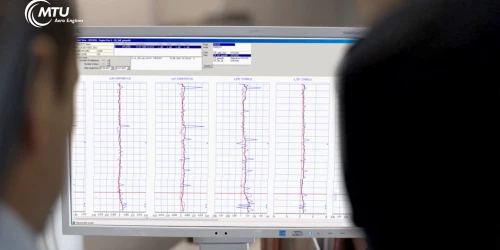

Engine Trend Monitoring
The engine early warning system monitors all key parameters during a flight. It detects even the slightest issues, which can then be fixed before they develop into anything more serious. To the video
More flying, less noise
All those involved know that changes in aviation can be implemented only with the acceptance of the public. “Above all, it’s a case of making aircraft so quiet that they make no or minimal disturbance,” says Roland Gerhards, CEO at the ZAL Center of Applied Aeronautical Research in Hamburg. While electric flying has the potential to reduce noise in the long term, fuel cells and small electric motors in the landing gear are prime candidates for significantly reducing noise in the short term, says Gerhards. “This would allow aircraft to coast their way silently to takeoff.” Both topics are currently being researched at the ZAL and could be ready for implementation within the next five to ten years.
Noise reduction also is an issue for aero engine manufacturers: The new generation of geared turbofan engines not only reduce fuel consumption and harmful emissions, but also reduce the noise footprint by up to 75 percent. This cuts the noise levels around an airport to a quarter of their present levels. As a result, it is possible to operate more aircraft without creating too much noise in the surrounding area, opening up room for future growth.







